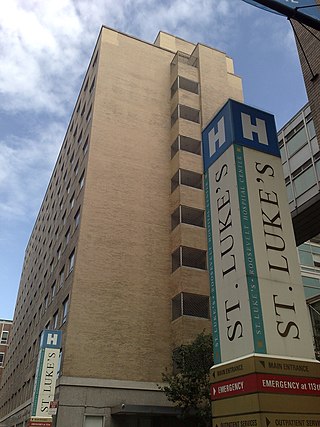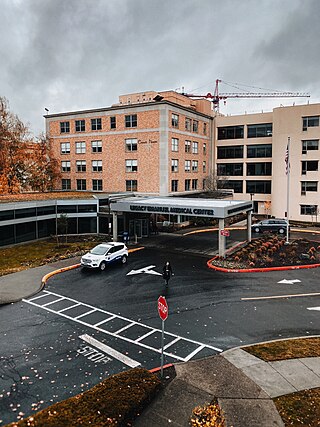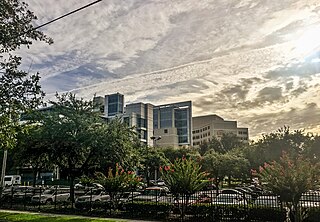
First Hill is a neighborhood in Seattle, Washington, United States. It is named for the hill on which it is located, which in turn is so named for being the first hill encountered while traveling east from downtown Seattle toward Lake Washington. First Hill is bounded on the west by Interstate 5, beyond which is Downtown, on the north by E. Pike and E. Madison Streets, beyond which is Capitol Hill, and on the south by Yesler Way, beyond which is the International District. The City of Seattle provides conflicting information about its eastern limit, beyond which are Cherry Hill and the Central District. Some describe it as being bounded by Broadway and Boren Avenues, while others describe it as being bounded by 12th Avenue.

Seattle is the largest city in the U.S. state of Washington and has several large medical facilities and institutions that serve the Pacific Northwest region. The University of Washington is consistently ranked among the country's leading institutions in medical research and manages the UW Medicine system, which owns and operates Harborview Medical Center, University of Washington Medical Center, and Northwest Hospital & Medical Center. Harborview is the only Level I trauma center in the Pacific Northwest and serves patients with traumatic injuries from the states of Washington, Alaska, Idaho, and Montana.

Swedish Health Services, formerly Swedish Medical Center, is the largest nonprofit health provider in the Seattle metropolitan area. It operates five hospital campuses, ambulatory care centers in the cities of Redmond and Mill Creek, and Swedish Medical Group, a network of more than 100 primary-care and specialty clinics.

Mount Sinai Morningside, formerly known as Mount Sinai St. Luke's, is a teaching hospital located in the Morningside Heights neighborhood of Manhattan in New York City. It is affiliated with the Icahn School of Medicine at Mount Sinai and the Mount Sinai Health System, a nonprofit hospital system formed by the merger of Continuum Health Partners and the Mount Sinai Medical Center in September 2013. It provides general medical and surgical facilities, ambulatory care, and a Level 2 Trauma Center, verified by the American College of Surgeons. From 1978 to 2020, it was affiliated with Mount Sinai West as part of St. Luke's–Roosevelt Hospital Center.

Legacy Emanuel Medical Center is a hospital located in the Eliot neighborhood of Portland, Oregon, United States. Founded in 1912, it is one of only two Level I trauma centers in the state of Oregon, and home to the only burn center between Seattle and Sacramento. The hospital is also home to the Life Flight Network (MEDEVAC), the first of its kind instituted on the U.S. West Coast. The 554-bed facility provides a full range of services, including conventional surgery, heart treatment, critical care, neurology/stroke care/brain surgery, and care for high-risk pregnancies. Legacy Emanuel also houses the Randall Children's Hospital. It is one of the hospitals in the area where gun shot victims are routinely brought in.

Intermountain Primary Children's Hospital (PCH) is a nationally ranked pediatric acute care children's teaching hospital located in Salt Lake City, Utah. The hospital has 289 pediatric beds and is affiliated with the University of Utah School of Medicine. The hospital is a member of Intermountain Healthcare (IHC) and is the only children's hospital in the network. The hospital provides comprehensive pediatric specialties and subspecialties to infants, children, teens, and young adults aged 0–21 throughout the Salt Lake City and outer region. PCH also sometimes treats adults that require pediatric care. PCH is a ACS verified Level 1 Pediatric Trauma Center and is the largest providers of pediatric health services in the state. The hospital serves the states of Utah, Nevada, Idaho, Montana, and Wyoming, yielding an enormous geographic catchment area of approximately 400,000 square miles. The hospital is one of the only pediatric hospitals in the region.

UF Health Jacksonville is a teaching hospital and medical system of the University of Florida in Jacksonville, Florida, United States. Part of the larger University of Florida Health system, it includes the 603-bed UF Health Jacksonville hospital, the 92-bed UF Health North hospital, associated clinics, and is the Jacksonville campus of UF's Health Science Center. Together with UF Health Shands Hospital in Gainesville, UF Health Jacksonville is one of two academic hospitals in the UF Health system, and serves 19 counties in Florida and several in Georgia.
St. Mary's General Hospital is an acute care hospital in Passaic, New Jersey that offers a range of health care services and community outreach programs. The hospital is located on a campus in Passaic that is bordered on the south by Oak Street, the north by Crescent Place, the west by Lafayette Avenue, and the east by Boulevard.
Calgary General Hospital was the name given to a series of medical facilities in the city of Calgary.
The Riverside University Health System - Medical Center, or RUHS-MC, formerly Riverside County Regional Medical Center, or RCRMC, and also formerly Riverside General Hospital University Medical Center, or RGH UMC, is a public teaching hospital located at 26520 Cactus Avenue, Moreno Valley, California, United States, operated by the County of Riverside. It is classified as a Level I Trauma Center.

Hospitals in Omaha, Nebraska have been integral to the city's growth since its founding in 1857. The city has a number of hospitals that were founded by religious groups, and has many medical centers resultant from the mergers of various hospitals. Nebraska is also home to a VA facility that was the only hospital in the United States with a nuclear reactor.

Providence Regional Medical Center Everett is a full-service medical center and the flagship hospital of Providence Health & Services, the largest faith-based healthcare system in the Northwestern United States. It serves patients from Snohomish County, Skagit County, Whatcom County, Island County, and San Juan County, Washington. Its two campuses are located in Downtown Everett, Washington.
Isabella Garnett founded the first hospital in the city of Evanston, Illinois that would serve African-American patients. After her hospital merged into Evanston's new Community Hospital in 1928, she served as superintendent of that institution for more than a decade. She remains one of Evanston's best-known historical African-American residents.
The town of Colorado Springs, Colorado, played an important role in the history of tuberculosis in the era before antituberculosis drugs and vaccines. Tuberculosis management before this era was difficult and often of limited effect. In the 19th century, a movement for tuberculosis treatment in hospital-like facilities called sanatoriums became prominent, especially in Europe and North America. Thus people sought tuberculosis treatment in Colorado Springs because of its dry climate and fresh mountain air. Some people stayed in boarding houses, while others sought the hospital-like facilities of sanatoriums. In the 1880s and 1890s, it is estimated that one-third of the people living in Colorado Springs had tuberculosis. The number of sanatoriums and hospitals increased into the twentieth century. During World War II, medicines were developed that successfully treated tuberculosis and by the late 1940s specialized tuberculosis treatment facilities were no longer needed.

Flint-Goodridge Hospital was a hospital in New Orleans, Louisiana. For almost a century (1896–1983) it served predominantly African-American patients and was the first black hospital in the South. For most of these years, was owned and operated by Dillard University, a historically black university. From 1932 until its closing in 1983 it was located on Louisiana Avenue in uptown New Orleans. Its former Louisiana Avenue facility is now listed in the US National Register of Historic Places.

The Hospital Reservation Historic District is located between Radio Station and Officers Row Historic Districts and east of the Marine Reservation Historic District of the Puget Sound Naval Shipyard in Washington, United States. Established in 1909, it reached its maximum development in 1942. The following structures no longer remain:
- ‘"Main Hospital Building"’ (1911,1924): a Neo-Classical, two story with basement brick complex.
- "’Recreation building"’ (1920): two story vernacular wood frame structure with basement; to the west was a yard cemetery, which was relocated to the Presidio in San Francisco, California.
- "’Navy Female Nurse Corps Quarters"’ (1921) was a two-story wood frame structure.
- "’Three Isolation Buildings"’ (1915) were located of the main hospital. Along with other buildings constructed here, all but one isolation building were eventually connected to the main hospital building.
The original Baptist Memorial Hospital was a 2,000-bed medical facility and complex of three hospital buildings located on 899 Madison Avenue in the vicinity of midtown Memphis, Tennessee. The facility closed in 2000, and was demolished in 2005 after 88 years of service. When Baptist transferred their main ownership to the Baptist Memorial Hospital-Memphis in eastern Memphis. It was once the world's largest privately owned hospital.












